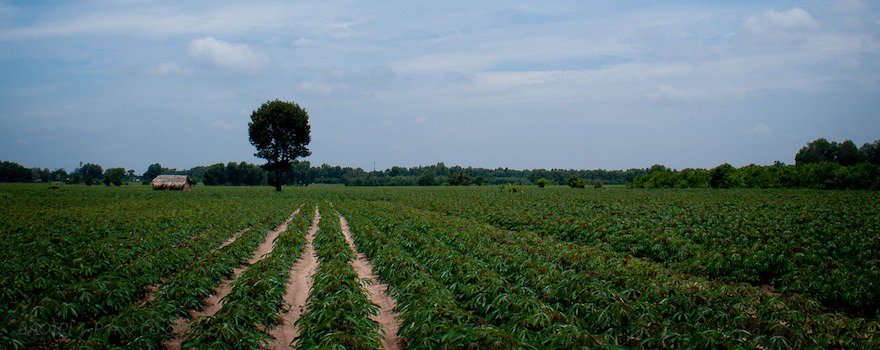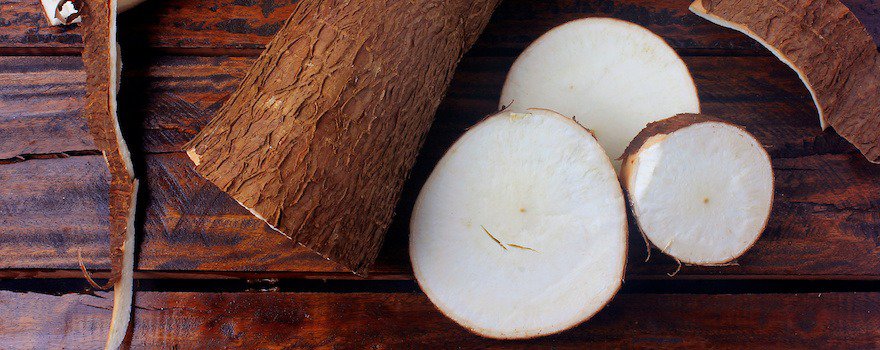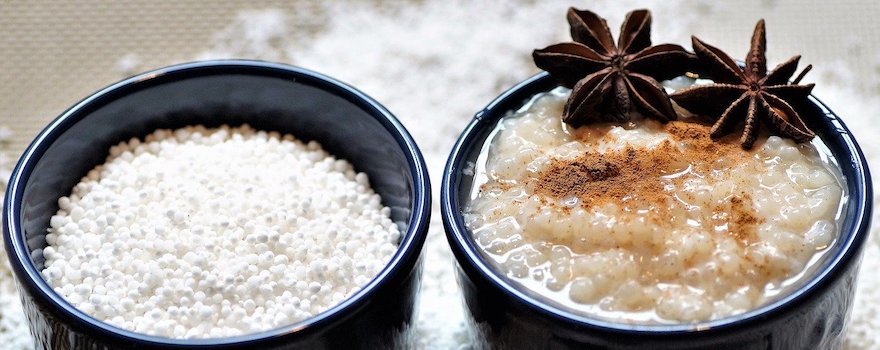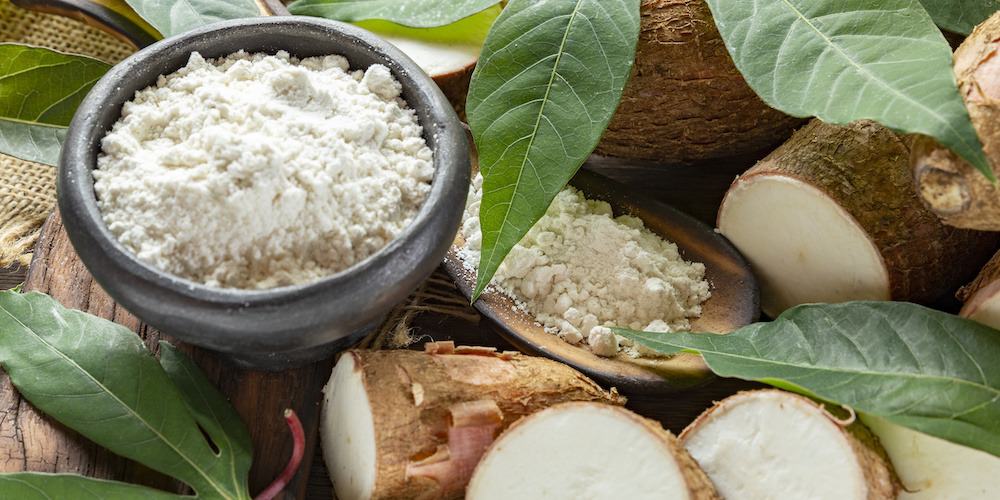BENEFITS OF CASSAVA
✓ Good source of carbohydrates
✓ Has antioxidant properties
✓ Helps relieve skin problems
✓ Reduces levels of bad cholesterol
✓ Improves digestive health and bowel movements
What is cassava?
Cassava, with the scientific name Manihot esculenta, is a shrub native to the tropical regions of Central and South America. Like the castor bean or the rubber tree, it belongs to the large family Euphorbiaceae, which includes nearly 6,000 species, including about one hundred species of the genus Manihot. Although many cultivars and hybrids exist today, the typical variety is Manihot esculenta Crantz.
Sometimes considered a root vegetable, cassava is a perennial plant that can reach 5 m in height. It is distinguished by its very long tuber which can measure 50 cm in length and 10 cm in diameter and weigh up to 5 kg ! It has a rough brown skin and a whitish flesh. It produces large leaves, which are also edible, and yellow flowers in capsules.

Originally, the shrub grows mainly in the Amazon region, in French Guiana and in Brazil. Its tuber was eaten fried, prepared as a broth, or ground to obtain flour. It was from the 16th century that cassava was introduced to Africa, where it is now widely consumed.
Il rentre notamment dans la préparation des pains de manioc, de l’attiéké, un met traditionnel de la Côte d’Ivoire, et du « fufu », une pâte consommée comme aliment de base en Afrique de l’Ouest. On le cultive aussi en Asie.
In addition to their taste qualities, the cassava tuber and leaves have undeniable nutritional benefits.
The tuber is an excellent source of carbohydrates and contains many minerals and trace elements. The leaves, meanwhile, are rich in antioxidants, proteins, and vitamins.
Thanks to this composition, cassava has a satiating and antioxidant effect. Its consumption is also recommended to relieve skin problems, improve digestion and reduce levels of bad cholesterol.
Nutritional composition
- 9 acides aminés
- Vitamines : provitamine A, B1, B2, B3, B5, B6, C, E, K
- Minéraux et oligo-éléments : magnésium, fer, calcium, potassium, sodium, phosphore, cuivre, manganèse, zinc
- Caroténoïdes : lutéine, bêta-carotène
- Fibres
- Protéines
- Lipides
- Glucides
- Polyphénols
- Eau

The benefits of cassava
🚴🏻♀️ Good source of carbohydrates
The cassava tuber is made up of 70% carbohydrates or carbohydrates. So much so that about 500 million people today depend on it as their primary source of carbohydrates.
Essential for providing energy to the body, carbohydrates are components of certain proteins, support glycogen stores and improve sleep by increasing the production of tryptophan.
It mainly contains complex carbohydrates in the form of starch (amylose and amylopectin). These have a satiating effect and regulate appetite. Once in the stomach, the starch swells, which speeds up the feeling of fullness. Although it is relatively high in calories (159 kcal per 100 g), it can be consumed to lose weight because of its strong satiety effect and its fiber content.
This review from the University of New England (Australia) looked at the nutritional composition of cassava, notably its good carbohydrate content in the context of animal feed.
🥝 Has antioxidant properties
Cassava is an interesting plant for limiting damage to the body induced by the action of free radicals. Its leaves notably contain polyphenols, vitamin C and carotenoids (lutein and beta-carotene). These nutrients and active compounds are involved in combating free radicals.
In some studies, cassava has shown promise for protecting the liver and limiting liver damage thanks to its antioxidant activity. Indeed, it contains two flavonols : quercetin and kaempferol. These have been shown to reduce the level of malondialdehyde, a marker of lipid oxidation by free radicals.
This study from the National Research Centre of Cairo (Egypt), conducted on rats, shows how the aqueous extract of cassava shoots reduces liver lesions by exerting antioxidant activity.
🍑 Soothes skin issues
When used topically, cassava leaves have an antibacterial effect particularly useful for improving skin problems. They act notably on Staphylococcus epidermidis, a bacterium of the skin flora that can become pathogenic, and on Propionibacterium acnes, responsible for acne.
The leaves are also rich in beta-carotene, a precursor of vitamin A which contributes to the renewal of skin cells. The tuber also contains various B-group vitamins that help maintain healthy skin.
Also read the 16 foods and dietary supplements good for the skin
This study from Padjadjaran University (Indonesia), conducted directly on clinical bacterial isolates, shows the antibacterial activity of cassava leaves.
🍳 Reduces bad cholesterol levels
Cassava appears effective in reducing the level of bad cholesterol (or ” LDL cholesterol “) in the blood and increasing that of good cholesterol (or ” HDL cholesterol “).
This action is due to its dietary fiber content and to the presence of L-fucose, a monosaccharide involved in many functional roles.
It also contains interesting amino acids. Lysine, for example, contributes to the production of carnitine, which lowers cholesterol levels. Not to mention the calcium and magnesium that combat excess LDL cholesterol.
This study by the Food and Nutrition Research Institute of Taguig (Philippines), conducted in humans, shows the beneficial effect of cassava on levels of bad cholesterol.
♻️ Improves digestive health and intestinal transit
The starch and fibers of cassava are recommended to improve bowel transit, prevent and relieve intestinal disorders such as constipation. Cassava’s anti-inflammatory action also helps reduce colon inflammation and inflammatory bowel diseases (IBD).
Furthermore, it is highly digestible and naturally gluten-free. It can therefore be consumed in cases of intolerance or celiac disease.
However, further studies are still needed to evaluate cassava’s effectiveness in improving bowel transit.

How to consume cassava?
Fresh cassava tuber
Fresh cassava tubers can be found in specialty stores and in African and Asian grocery stores. A good-quality cassava should be firm, free of mold or slimy parts, and without a strong odor.
The cassava tuber can be cooked in a multitude of ways : fried, steamed, mashed, in fritters… Its taste, similar to that of the potato, pairs very well with fish or meat. It is even possible to incorporate it into desserts (cakes, pancakes…) for original and tasty recipes.
Cassava leaves
The tender leaves of cassava are also useful in cooking. They are notably used in the preparation of ravitoto, a traditional Malagasy recipe made from chopped leaves.
You can cook them like spinach, making sure to cook them thoroughly. Their leaves pair wonderfully with meat, fish, and starchy foods.

Cassava flour
After harvest, cassava tubers are first washed and then soaked in water (retting) for several days. They are then dried and ground to obtain the valuable flour.
Naturally gluten-free, cassava flour is suitable for people with celiac disease and is an excellent substitute for wheat flour. It is ideal in baking to add moistness to culinary preparations: cookies, cakes, crêpes…
In savory form, it is enjoyed as «pão de queijo», a small Brazilian cheese bun, in vegetable patties, or as «farofa», a typical Brazilian side dish.

Sweet or bitter cassava ?
There are two kinds of cassava: sweet cassava and bitter cassava. The first is the one most often found at market stalls and is cooked like a vegetable.
The second, however, is toxic when raw (because it contains hydrocyanic acid) and must therefore be processed. That is why it is mainly used to make flour or tapioca starch.
Cassava flour or tapioca starch ?
Be careful not to confuse cassava flour with tapioca starch. Indeed, tapioca starch is obtained from the starch contained in the tuber of bitter cassava. The starch is then cooked and ground to obtain small tapioca pearls.
Tapioca starch is used for its thickening properties. It adds body to dishes, sauces, and desserts…

Cassava and superfoods
To relieve digestive disorders, cassava pairs well with superfoods rich in fiber such as carob and root vegetables like the Jerusalem artichoke.
To stay slim or lose weight, it can be paired with other natural appetite suppressants such as cacao that increase the feeling of fullness.
Sustainable consumption: prioritize organic and fair-trade cassava
✓ Today, 70% of the world’s cassava is produced in Nigeria, Brazil, Indonesia, the Democratic Republic of the Congo, and Thailand. It is mainly grown by smallholder farmers with low incomes. Cassava represents an important source of income and food security for them. That is why we recommend choosing a fair trade product that guarantees fair prices and values the work of these producers.
✓ In France, it is cultivated in certain departments and overseas regions such as Réunion or the Antilles. But production is rarely exported to the mainland.
✓ Finally, choose cassava from organic farming, grown without chemical fertilizers, pesticides, or insecticides.
Dosage
There is no real recommended dosage for cassava consumption. Simply make sure to not overdo it because it is fairly high in calories compared to other root vegetables.
🥔 Fresh tuber : 250 g per person per day.
🌱 Leaves : 500 g for 1 to 2 liters of water.
🥄 In flour : substitute the same amount of cassava flour for wheat flour.
Contraindications and side effects
Cassava consumption has some contraindications. It is particularly not recommended for people suffering from an iodine deficiency or thyroid problems.
In addition, the tuber contains cyanogenic glycosides (linamarin and lotaustralin) that can be converted into hydrogen cyanide and cause poisoning with the following side effects:
- Maux de tête
- Maux d’estomac
- Vomissements
- Diarrhée
If you experience side effects, stop consuming it and consult a doctor.
History, cultivation and market of cassava
With 250 million tons produced each year, cassava is the 5th most widely cultivated food crop in the world, after corn, rice, wheat and potatoes. Africa accounts for 47% of global production. It has become the continent’s main food source and a staple for a large number of people.
But global warming is weighing heavily on this crop. It encourages pest insect populations and the development of viral diseases (African mosaic and cassava brown streak) which cause significant damage in the fields. An international partnership has even been set up to respond to the threat of cassava diseases in Africa (Global Cassava Partnership for the 21st Century).
Report compiled by Julia Perez and Charlotte Jean
Sources and scientific studies
Younoussa Diallo, Momar Talla Gueye, Mama Sakho, Praxède Gbaguidi Darboux, Amadou Kane, Jean-Paul Barthelemy & Georges Lognay, 2012. Nutritional importance of cassava and prospects for staple food in Senegal (literature review).
Julie A. Montagnac Christopher R. Davis Sherry A. Tanumihardjo, 2009. Nutritional Value of Cassava for Use as a Staple Food and Recent Advances for Improvement.
Natalie K. Morgan and Mingan Choct, 2016. Cassava: Nutrient composition and nutritive value in poultry diets.
Abdelsamed Elshamy, Abd El-Nasser G El Gendy, Abdel Razik H Farrag, Jihan Hussein, Nadia A Mohamed, Walaa A El-Kashak, Simona Nardoni, Francesca Mancianti, Marinella De Leo, Luisa Pistelli, 2020. Shoot Aqueous Extract of Manihot esculenta Crantz (Cassava) Acts as a Protective Agent Against Paracetamol-Induced Liver Injury.
Resmi Mustarichie, Sulistiyaningsih Sulistyaningsih, Dudi Runadi, 2020. Antibacterial Activity Test of Extracts and Fractions of Cassava Leaves ( Manihot esculenta Crantz) Against Clinical Isolates of Staphylococcus epidermidis and Propionibacterium acnes Causing Acne.
Trinidad P. Trinidad, Rosario S. Sagum, Aida C. Mallillin, Melissa S. Borlagdan, Marco P. de Leon, Theressa F. Aviles, 2013. Sweet Potato and Cassava Can Modify Cholesterol Profile in Humans with Moderately Raised Serum Cholesterol Levels.



